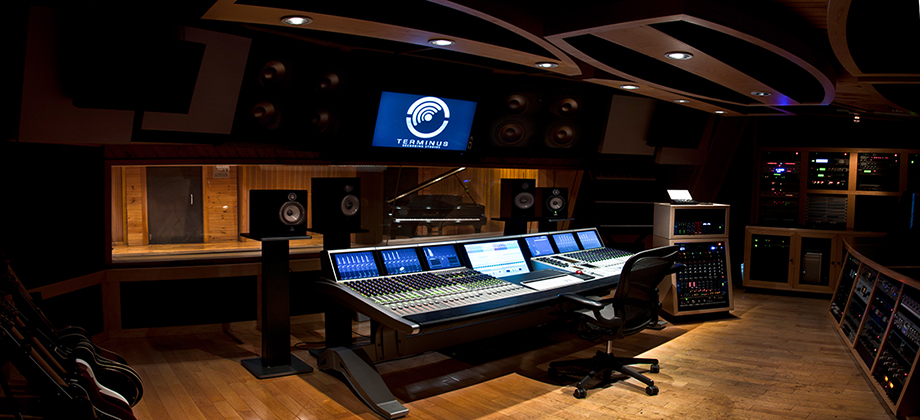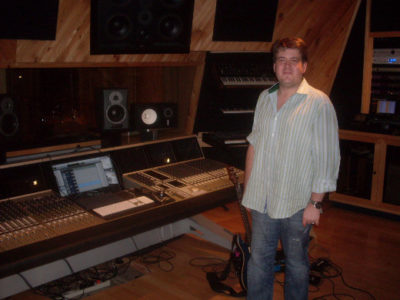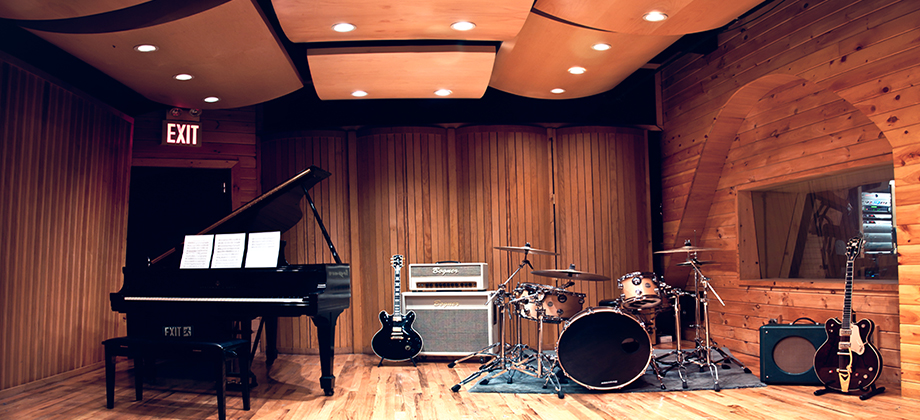Trouble in Times Square: Terminus Recording Studios Is Closing
After a decade in business, Terminus Recording Studios is closing down.
Originally launched in 2006 as Tainted Blue Studios by owner Andrew Koss, the facility occupied the highly desirable penthouse floor of 723 7th Avenue. Terminus has stopped taking bookings and will formally vacate the space by the end of July.
The closure comes after two names and two large-format consoles, and leaves one of New York City’s top-tier live rooms remaining to be claimed. It also may mark the end of one of the city’s most appealing control rooms, a highly flexible and inspiring space designed by the late Lawrence P. Swist.
When he opened it as Tainted Blue, Koss (who is also a contributor to SonicScoop) had initially planned for the studio to be a private facility, for use by invited artists and himself on his personal musical projects. In 2010 the studio took a more business-oriented turn when Koss switched out their SSL 9080J for the Euphonix System 5. It then became even more public-facing in 2012 with the name change to Terminus, which was accompanied by the hiring of studio manager Christian Rutledge, the addition of a writing/production room, and a significant influx of new gear.
Artist Focused
When Quad Studios’ penthouse at 723 7th Avenue was sold in 2006 and Koss took the reins, the vision was for a facility that put creativity first and foremost. “We always wanted to focus on the producer element and the creative aspects of a studio,” Koss says. “The objective was a place that was not only warm feeling, but conducive to being in the moment. That meant a lot of nice instruments were there and ready to play, from keeping the piano in tune to having all of the latest soft synths.”
It was a strategy that attracted plenty of clients over the years. Just a small sampling included producers such as Eddie Kramer, Neil Dorfsman, James Brown, and Randy Jackson, artists including Akon, American Idiot, Sebastian Bach, Bear Hands, Boys Like Girls, Michael Cera, DJ Khalid, Fabulous, Future, Scarlet Johanson, Jim Jones, Just Ivy, KDrew, Kelis, Alicia Keys, Kinky Boots, DJ Khalid, John Legend, LMFAO, Mama Mia, Taryn Manning, Liza Minnelli, Papa Roach, Andre Previn, A.R Rahman, Danny Teneglia, Vado, and brands including CBS, College Humor, MLB, MTV, NPR, and VH1.
Koss collaborated with Swist on an analog/digital design that made the ergonomically advanced control room optimized for music creation, in addition to the standard tasks of tracking and mixing.
“It’s a really special control room,” reflects Koss. “Larry did a spectacular job with a limited budget. Every day you could come in there, and you were ready to work. I’ll miss it, but the inspiration of that room will be incorporated into anything else that I do.”
A Studio Minefield
Although both of Terminus’ vertical neighbors in 723 7th Avenue, Quad Recording Studios and Premier Studios are reporting a strong 2016, the challenges facing high-end NYC facilities are myriad. The particular complexities of operating in midtown are exemplified by last month’s closing of MSR Studios, just around the corner from Terminus on West 48th Street.
“We had an option on the lease – it was either out now or in five more years,” Koss explains of Terminus’ real estate situation. “Even if we were fully booked, the studio wasn’t going to earn enough to cover our costs and justify everyone’s time. At the same time, I found I wasn’t able to pursue any of my own projects because of how much the studio was being used. So it became hard to logically argue for moving forward.”
While Terminus was somewhat shielded from the noise of Times Square’s nonstop construction many floors below, the neighborhood’s havoc didn’t help, nor did 723’s notoriously quirky elevators. “The sheer craziness of things outside was always an issue,” notes Koss. “And the functionality of the building itself was as well. Having a big name artist arrive and telling her that she has to take the freight elevator and then walk a flight upstairs was embarrassing – that’s not the business model we wanted.”
Other hazards Terminus faced included the downward pressure on pricing familiar to many facilities. “We got to work on a lot of cool projects, it’s just that people are constantly trying to bargain you down on the price, and they also have less and less time to do what they want to do,” he says. “Even when the place was busy we were struggling to stay in the black. Maybe outside of Manhattan it could be a cost-effective business model.”
A first time studio-owner when he opened Tainted Blue in 2006, Koss realizes how much of a Learning Experience he had ahead of him.
“I know now how much of a full-service role it is,” he says of running the studio. “It’s not just about the instruments and gear, it’s the accommodation of everything that goes into the space. The balance of attracting artists versus attracting engineers for producers, or label people who are making decisions on a purely financial basis. It’s particularly difficult trying to manage the rate that you give to one person versus someone else – you have to keep an even playing field, and not sell yourself short. Believing in the value of what you have is an important lesson.”
Switcheroo
One of the more intriguing chapters of Terminus’ story was when the studio switched from a desk that seemed like a sure thing among music clients – an SSL 9080J — to the less ubiquitous Euphonix System 5 digital audio mixing system in 2010.
“I don’t know if it was the right or wrong decision,” Koss admits, looking back on the move. “I wouldn’t do it differently. The sheer cost of maintenance and energy efficiency of the old SSL – I don’t know if we would have stayed open this long if we were still paying for it monthly. Sometimes I criticize myself about the decision, and I wish more people were willing to take the plunge with us and try it.
“I still swear by the Euphonix, especially with the sizable increase of outboard gear around it. The engineers had a blast with it. I know it was a foreign object to a lot of people, but I think inevitably more rooms are going to end up moving toward smaller control surfaces – you can do so much now with them and 500 series modules. I also finally jumped on board with the Universal Audio UAD stuff, and I can’t deny that it sounds damn good.
“The System 5 was a match for our philosophy,” he continues, “which was to get it right on the inbound. You can mix it all you want, but if you capture the sound quality you’re already ahead of the curve.”
This time-lapse video reduces an SSL-to-Euphonix console switch to a mere 3:33.
Audio Talent Tree
One of the toughest aspects of a studio closing is the audio professionals who are put out of work as result. In Terminus’ case, the loss also deprives NYC of a prolific training ground for interns, many of whom have gone on to launch solid careers after starting out at the 723 7th Avenue penthouse.
“We were always steadfast to the idea of a small but talented staff of engineers and interns,” states Koss. “We didn’t want five guys standing around: We were very selective about who we picked, but they were expected to be an engineer and they had to pick up the slack pretty quickly and learn their role. Christian was always very good at keeping them in the right mindset.
“By giving them respect and allowing them to grow and use the studio after hours, our interns were able to get their hands dirty and spend a lot of time on the equipment. So they learned faster, got better at it, and learned how to deal with situations so they didn’t have to call for help. They appreciated that, and in turn we were constantly able to have a team of well-prepared engineers and interns coming in all the time. I think that was a great part about what we were doing. I know a lot of those engineers are working all over the city in big venues – hopefully we provided a good foundation.”
Another positive outcome for Koss are the happy recollections accumulated from a decade in the space. “One of my favorite things here was turning the live room into a live venue and streaming the performances – I always loved those,” he recalls. “Any time I got to track drums with a great drummer was a highlight, because the room was so explosively fun to record drums in. I won’t name-drop, but when top engineers came in it was pretty special to watch really talented people do their thing.
“And of course to work with all the great artists that we had here was terrific. Watching Andre Previn walk slowly off our elevator and, with great effort, walk towards the piano, sit down, and then play with the fire and strength of a 25-year-old is one of my fond memories.”
NYC Implications
As always, the closing of any serious NYC facility sparks the question: Is the time of the big studio past in New York City?
“The one thing that New York lacks is space,” Koss observes. “That’s a huge problem for the recording environment here. When I go out to LA or Nashville and you see the sprawling facilities that are still doing fine because the cost to exist is so much lower, and they have so much more space, it’s just staggering.
“Between the rent and the sound issues that you have to deal with in Manhattan proper, the most successful way to work is that the studio has to be generating its own business – if they’re doing in-house publishing work, or if there’s a revenue stream that’s not just based off of time. The problem is that space in NYC is always worth more as something else [other than a studio]. I don’t think it means that the world of large studio spaces is past, but I don’t know if Manhattan can keep it up. So much work is done in pre-production elsewhere, no one needs three weeks of tracking.”
Interestingly, Koss sees a production environment that’s improved overall for studios now as opposed to 10 years ago. “I actually think that it’s gotten better than it was,” he says. “I think that 10 years ago people were getting hardcore into that do-it-all-on-my-own-in-my-own-room mentality, but then they hit the creative wall in their bedroom.
“So at one level it’s resurged a bit in terms of people wanting good vocal mics and acoustic spaces, but due to the natural progression of rent and cost of operations, studios still couldn’t get an advantage. And we didn’t go back to the era of the long book-ins, the lockouts. When Terminus did get those inquiries, the client’s proposed budget wasn’t enough to cover our costs.”
Parting Is Sweet Sorrow
While the Terminus team turns to decommissioning the space, there will be plenty of speculation about whether it remains a studio in some form, or moves onto another use. Meanwhile, Koss will focus on writing and producing music, leaving his facility behind with emotions best described as bittersweet.
“It was a really wonderful space to work in, and for artists to come to,” says Koss. “Between the undiscovered talent in the big names that worked here, there was always a constant approval and appreciation of what we did with that space. It clicked for a lot of very talented engineers, and I’m proud of what Larry and I tried to create with these rooms. I think we achieved that.
“So it’s sad, because I would have liked to see it do better. It’s just the reality of things. I’m looking forward to moving on to something even more freeing and creative.”
- David Weiss
Please note: When you buy products through links on this page, we may earn an affiliate commission.










